Thomas Gowland
December 12, 2016
While visiting the Somme battlefields in France, I received a Royal British Legion remembrance collection 2016 booklet. When looking into it, I saw so many things I'd like to order, but one thing especially caught the eye, the Somme 1916 Poppy lapel pin. This lapel pin is an exclusive tribute to those who fell during the Battle of the Somme in 1916. The pins are crafted using brass fuses from British shells fired during the battle, while the enamel paint contains earth from the British front line, meaning each one contains the very essence of the historic battlefield.Each pin commemorates a soldier that fell during the Battle of the Somme, my pin commemorates Sergeant Thomas Gowland. Although there is no real adoption program, I do see the grave of Thomas Gowland as my first British adoption grave.
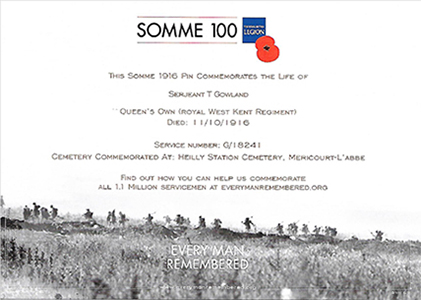 |
Before the war
Thomas Gowland was born in Houghton-le-Spring on June 3, 1890. Houghton-le-Spring is a town in North East England, which has its recorded origins in Norman times.The family moved from Houghton-le-Spring to Stanley somewhere between 1902 and 1905. Thomas was a putter in the coal miner before he joined the war. As well Houghton as Stanley used to be well-known mining towns in the county of Tyne and Wear.
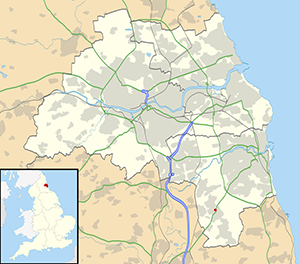 |
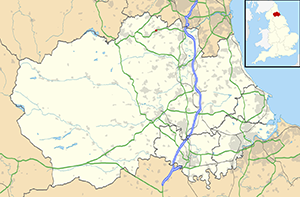 |
Houghton-le-Spring |
Stanley |
Thomas Gowland married Lenora Marshall Moore Probert on June 27, 1914, one day before Gravrilo Prinçip shot Archduke Franz Ferdinand and his wife Sophie in Sarajevo and started the First World War. Their first son, Anthony Gowland, was born on August 12, 1914. They had a second son, Thomas Gowland. He was born on September 6, 1916, but he died after 14 months from nephritis, kidney disease and bronchial pneumonia at the Freeman hospital in Newcastle.
In the army
Thomas originally enlisted in the 1st Northern General Hospital, Royal Army Medical Corps as Private 1505 on December 2, 1914.He was discharged on June 11, 1915 for the purpose of re-enlistment. On June 12, 1915 he joined the 19th Service Battalion, Royal Fusiliers in Newcastle. From August 1915 to June 1916 he promoted three times. On August 30, 1916, Thomas went overseas to France.
Thomas was part of a draft of 50 men that joined the 11th Battalion of the (Queen's Own) Royal West Kent Regiment in Dernancourt, France on September 13/14, 1916.
The Battalion was in Dernancourt on October 1, 1916. From there they moved south of Mametz Wood on the 2nd, passing through Dernancourt, Méaulte and Fricourt. Here the Battalion relieved the 1st New Zealand Rifle Brigade on the 3rd October and remained in the trenches until the 6th.
On October 7 the Battalion attacked the German trenches, supported by the 15th Hampshire Regiment on the right and the 140th Infantry Brigade on the left. They were only able to advance about 130 meters from the front line because they were held up by enemy machine gun fire coming from the flanks and the front. Heavy casualties were incurred in this advance.
After Thomas Gowland was wounded in action, he was taken to the 36th Casualty Clearing Station in Heilly. The picture below was taken in July 1916 where you can see what should be the 36th Casualty Clearing Station in the back of the picture, next to the railroad, which is still there today. On the other picture you see the location and the location of the cemetery. Thanks to David, a man who did a lot of research on the 36th CSS, I was able to retrieve a map of the actual 36th CCS. I made an basic sketch of the map on Google Earth to point out the exact location of the 36th CSS.
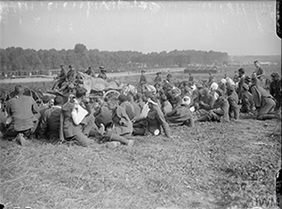 |
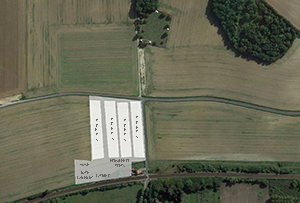 |
Death of Thomas Gowland
Thomas Gowland died of his wounds sustained during the Battle of the Somme on October 11, 1916 at the 36th Casualty Clearing Station that was located at Heilly that moment.He is buried at Heilly Station cemetery in Méricourt-l'Abbé. He rests at plot IV, row A, grave 81.
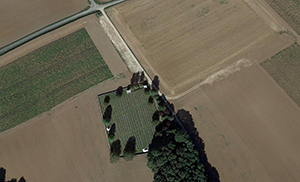
Heilly Station Cemetery, Méricourt-l'Abbé, France |
11th Battalion, Queen's Own (Royal West Kent Regiment)
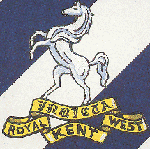 Royal West Kent Regiment |
The Queen's Own Royal West Kent Regiment was a line infantry regiment of the British Army, based in the county of Kent in existence from 1881 to 1961. The regiment was created on July 1, 1881 as part of the Childers Reforms, originally as the Queen's Own (Royal West Kent Regiment), by the amalgamation of the 50th (Queen's Own) Regiment of Foot and the 97th (The Earl of Ulster's) Regiment of Foot.
During WWI over 60.000 men served with the Queen's Own (Royal West Kent Regiment). The 1st Battalion was a Regular Army Unit in 1914 and was one of the first units to be moved to France. Among its fist major engagements were the Battle of Mons on August 23, 1914 and the Battle of Le Cateau on August 26, 1914. In October 1914 the battalion made a heroic stand during the Battle of Neuve Chapelle, being the only unit not to fall back.
The 11th (Lewisham) Battalion of the Royal West Kent Regiment was raised at Lewisham on May 5, 1915 by the Mayor and a local committee. They trained at Catford and joined the 118th Brigade, 39th Division in July. In October they transferred to 122nd Brigade, 41st Division. They moved to Aldershot for final training in January 1916 and proceeded to France on May 3, 1916.
In 1916 they were in action at the Battle of Flers-Courcelette and the Battle of Transloy Ridges during the Battle of the Somme. In 1917 they fought during the Battle of Messines, the Battle of Pilkem Ridge, the Battle of Menin Road and took part in the operations on the Flanders coast. In November 1917 the Division was sent to Mantua in Italy where they took the front line near the river Piave, north west of Treviso. In February 1918 they were sent back to France by train to concentrate near Doullens and Mondicourt. On March 16, 1918 the Battalion were disbanded in France with troops transferring to other units.
There were three VC's in the Queen's Owns (Royal West Kent Regiment). 6.866 officers and other ranks lost their lives and many thousands more got wounded.
Contact
Since December 2016 I have been searching for relatives of Thomas Gowland. I have been searching in Houghton-le-Spring where Thomas grew up.In 2018 I did another major search, this time through websites like Ancestry, where I found a family tree. I contacted the owner of the family tree and I received an e-mail back stating that this man, Tony Gowland, is the grandson of Thomas Gowland. I am very happy that my research paid off. Now I hope to find some more information about Thomas Gowland.
Personal information
Sergeant, British ArmyService # G/18241
11th Battalion, Queen's Own (Royal West Kent Regiment)
Enlisted in Newcastle-on-Tyne on December 2, 1914
Born: June 3, 1890 in Houghton-le-Spring, Durham
Hometown: Stanley, Durham
Died: October 11, 1916, 36th Casualty Clearing Station, Heilly, France
Status: died of wounds (DOW)
Buried: Plot IV, row A, grave 81, Heilly Station Cemetery, Méricourt-l'Abbé, France
Awards: /
Family
Wife: Lenora Marshall Moore Probert (1892-1965)
Sons: Athony Gowland (1914-1996), Thomas Gowland (1916-1917)
Father: Anthony Gowland (1859-1945)
Mother: Dorothy Ellen Davison (1863-1935)
Brothers: Thompson (1882-1974), Anthony (1896-?)
Sisters: Jane (1884-1974), Margaret (1888-1981), Elizabeth (1894-?), Mary (1896-1905), Dorothy (1899-?), Kate (1902-?), Elsie (1907-?)
More pictures
Thomas Gowland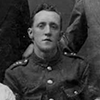
Family
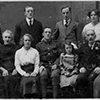
Graf
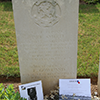
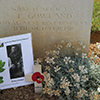
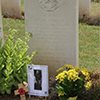

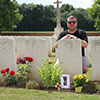
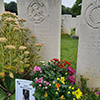
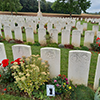
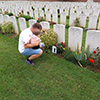
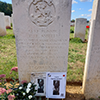
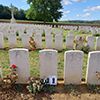
Heilly Station Cemetery
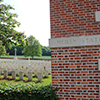
Documenten
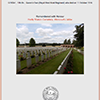
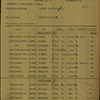
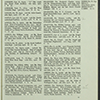
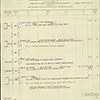
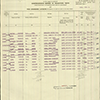
Diversen
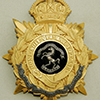
Sources
Any information you can provide me about this soldier, can be mailed to me (nicklieten at hotmail.com). Thank you!